This document describes an OFDM simulation using Matlab. It begins with an introduction to OFDM and its advantages for wireless communications. It then provides the mathematical equations for OFDM transmission and reception based on the DVB-T standard. The document outlines the steps to simulate OFDM transmission in Matlab, including generating OFDM symbols using an IFFT, adding a guard interval, pulse shaping, and upconverting to a carrier frequency. It also provides the equations and steps for simulating OFDM reception. Figures and tables are included to illustrate the simulation results and parameters.
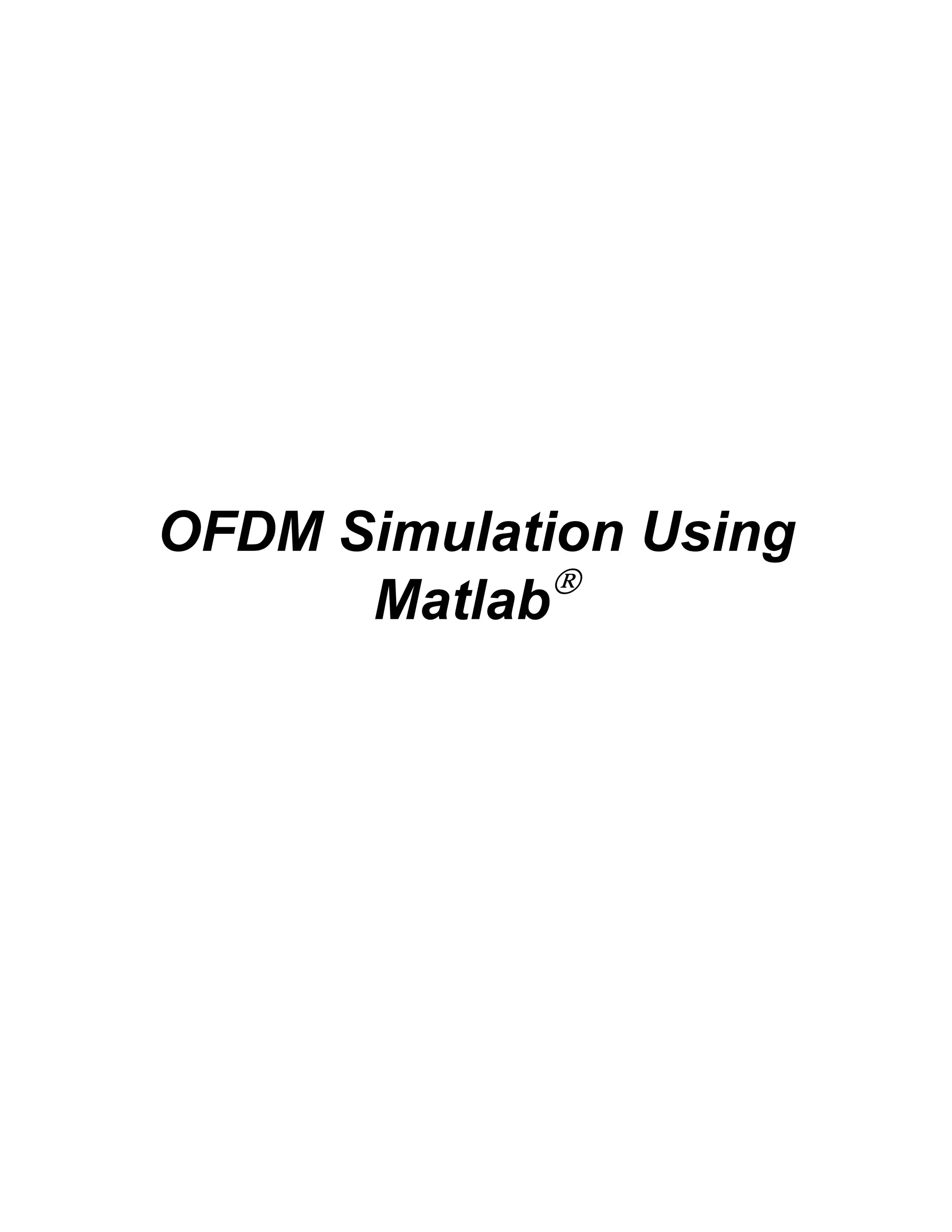
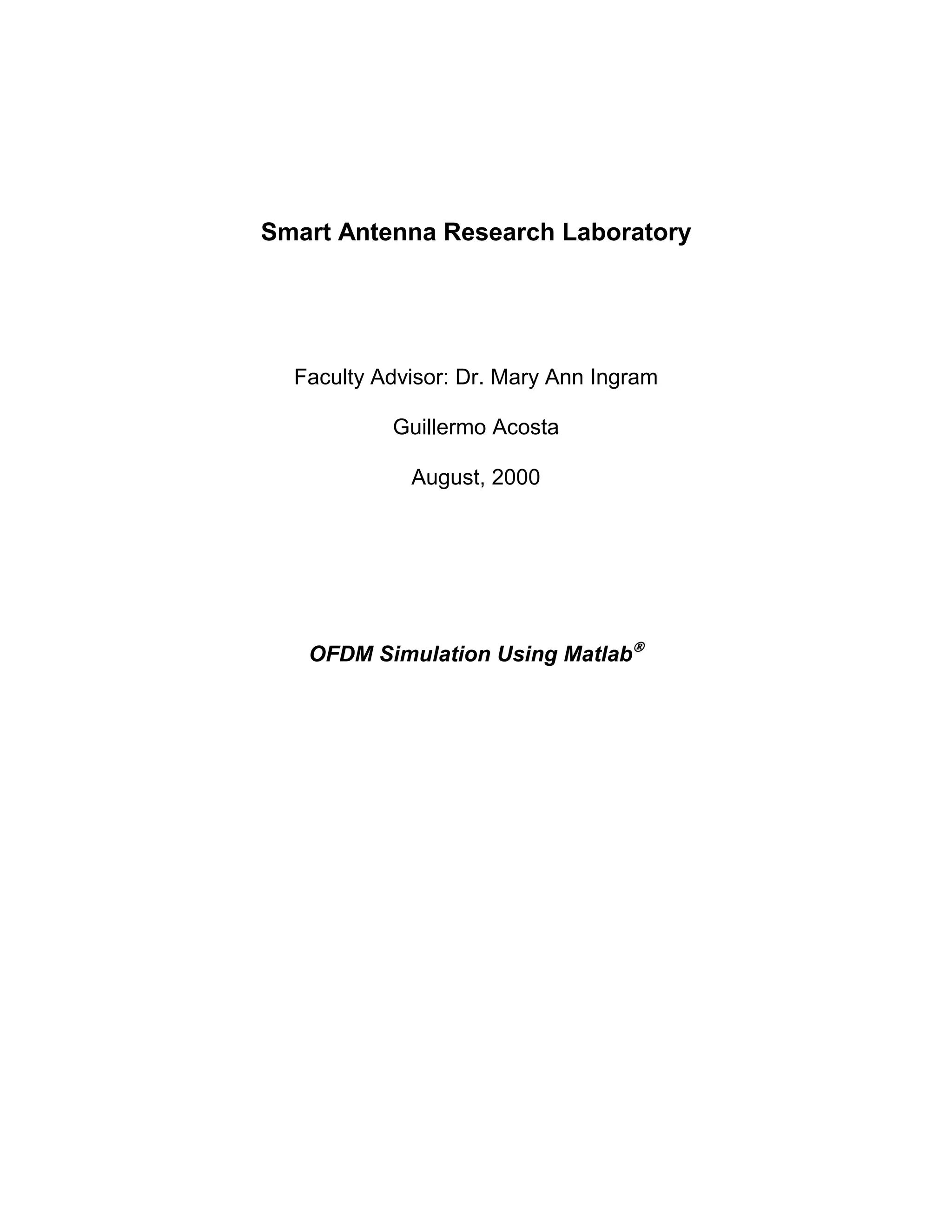
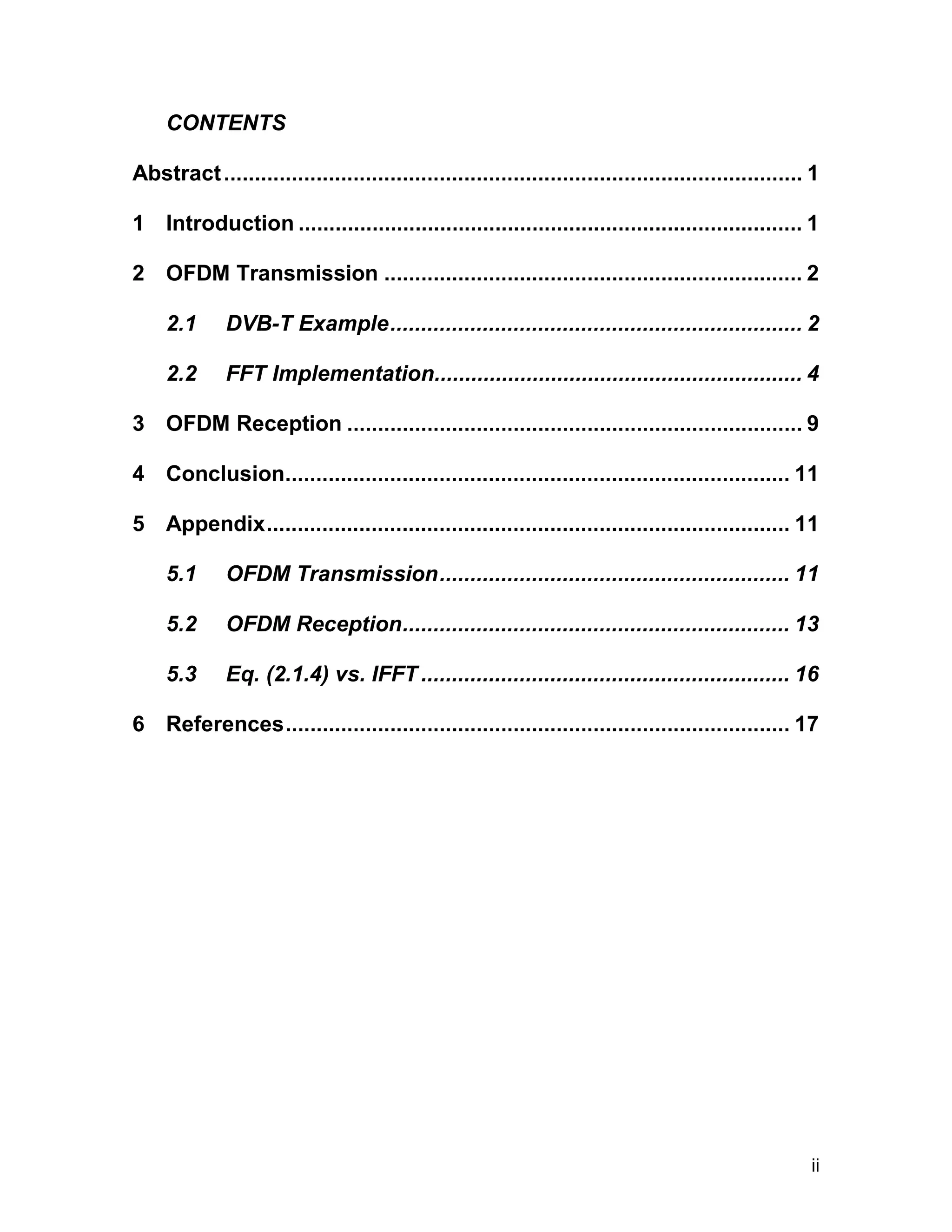
![FIGURES AND TABLES
Figure 1.1: DVB-T transmitter [1].............................................................................2
Figure 2.1: OFDM symbol generation simulation. ...................................................5
Figure 2.2: Time response of signal carriers at (B)..................................................5
Figure 2.3: Frequency response of signal carriers at (B).........................................5
Figure 2.4: Pulse shape g(t). ...................................................................................6
Figure 2.5: D/A filter response. ................................................................................6
Figure 2.6: Time response of signal U at (C). ..........................................................6
Figure 2.7: Frequency response of signal U at (C) ..................................................6
Figure 2.8: Time response of signal UOFT at (D)....................................................7
Figure 2.9: Frequency response of signal UOFT at (D). ..........................................7
Figure 2.10: uoftI (t)cos(2π fct) frequency response.................................................7
Figure 2.11: ( )sin(2 ) Q c uoft t π f t frequency response..................................................7
Figure 2.12: Time response of signal s(t) at (E).......................................................8
Figure 2.13: Frequency response of signal s(t) at (E)..............................................8
Figure 2.14: Time response of direct simulation of (2.1.4) and IFFT. ......................8
Figure 2.15: Frequency response of direct simulation of (2.1.4) and IFFT. .............8
Figure 3.1: OFDM reception simulation. ..................................................................9
Figure 3.2: Time response of signal r_tilde at (F). ...................................................9
Figure 3.3: Frequency response of signal r_tilde at (F). ..........................................9
Figure 3.4: Time response of signal r_info at (G). .................................................10
Figure 3.5: Frequency response of signal r_info at (G)..........................................10
Figure 3.6: Time response of signal r_data at (H). ................................................10
Figure 3.7: Frequency response of signal r_data at (H).........................................10
Figure 3.8: info_h constellation..............................................................................10
Figure 3.9: a_hat constellation...............................................................................10
Table 1: Numerical values for the OFDM parameters for the 2k mode....................4
iii](https://image.slidesharecdn.com/ofdm-sim-matlab-code-tutorialweb-141001030102-phpapp02/75/Ofdm-sim-matlab-code-tutorial-web-for-EE-students-4-2048.jpg)
![Abstract
Orthogonal frequency division multiplexing (OFDM) is becoming the chosen
modulation technique for wireless communications. OFDM can provide large data
rates with sufficient robustness to radio channel impairments. Many research cen-ters
in the world have specialized teams working in the optimization of OFDM for
countless applications. Here, at the Georgia Institute of Technology, one of such
teams is in Dr. M. A. Ingram’s Smart Antenna Research Laboratory (SARL), a part
of the Georgia Center for Advanced Telecommunications Technology (GCATT).
The purpose of this report is to provide Matlab code to simulate the basic proc-essing
involved in the generation and reception of an OFDM signal in a physical
channel and to provide a description of each of the steps involved. For this pur-pose,
we shall use, as an example, one of the proposed OFDM signals of the Digi-tal
Video Broadcasting (DVB) standard for the European terrestrial digital television
(DTV) service.
1 Introduction
In an OFDM scheme, a large number of orthogonal, overlapping, narrow band
sub-channels or subcarriers, transmitted in parallel, divide the available transmis-sion
bandwidth. The separation of the subcarriers is theoretically minimal such that
there is a very compact spectral utilization. The attraction of OFDM is mainly due to
how the system handles the multipath interference at the receiver. Multipath gen-erates
two effects: frequency selective fading and intersymbol interference (ISI).
The "flatness" perceived by a narrow-band channel overcomes the former, and
modulating at a very low symbol rate, which makes the symbols much longer than
the channel impulse response, diminishes the latter. Using powerful error correct-ing
codes together with time and frequency interleaving yields even more robust-ness
against frequency selective fading, and the insertion of an extra guard interval
between consecutive OFDM symbols can reduce the effects of ISI even more.
Thus, an equalizer in the receiver is not necessary.
There are two main drawbacks with OFDM, the large dynamic range of the
signal (also referred as peak-to average [PAR] ratio) and its sensitivity to frequency
errors. These in turn are the main research topics of OFDM in many research cen-ters
around the world, including the SARL.
A block diagram of the European DVB-T standard is shown in Figure 1.1. Most
of the processes described in this diagram are performed within a digital signal
processor (DSP), but the aforementioned drawbacks occur in the physical channel;
i.e., the output signal of this system. Therefore, it is the purpose of this project to
provide a description of each of the steps involved in the generation of this signal
and the Matlab code for their simulation. We expect that the results obtained can
provide a useful reference material for future projects of the SARL’s team. In other
words, this project will concentrate only in the blocks labeled OFDM, D/A, and
Front End of Figure 1.1.](https://image.slidesharecdn.com/ofdm-sim-matlab-code-tutorialweb-141001030102-phpapp02/75/Ofdm-sim-matlab-code-tutorial-web-for-EE-students-5-2048.jpg)
![We only have transmission regulations in the DVB-T standard since the recep-tion
system should be open to promote competition among receivers’ manufactur-ers.
We shall try to portray a general receiver system to have a complete system
Figure 1.1: DVB-T transmitter [1]
Σ (2.1.1)
2
description.
2 OFDM Transmission
2.1 DVB-T Example
A detailed description of OFDM can be found in [2] where we can find the
expression for one OFDM symbol starting at t = ts as follows:
1
s t d j f i t t t t t T
= Re exp 2 − + 0.5 − ,
≤ ≤ +
= < ∧ > +
( ) ( ) 2
2
2
( ) 0,
Ns
s
Ns
i N c s s s
i
s s
T
s t t t t t T
π
−
+
=−
where i d are complex modulation symbols, s N is the number of subcarriers, T the
symbol duration, and c f the carrier frequency. A particular version of (2.1.1) is
given in the DVB-T standard as the emitted signal. The expression is](https://image.slidesharecdn.com/ofdm-sim-matlab-code-tutorialweb-141001030102-phpapp02/75/Ofdm-sim-matlab-code-tutorial-web-for-EE-students-6-2048.jpg)
![s c ψ (2.1.2)
3
∞ 67
= ΣΣ Σ ⋅ max
(t) Re e j2π fct (t)
min
K
m,l,k m,l,k
m=0 l=0 k=K
where
π ′ −Δ− ⋅ − ⋅ ⋅
2 ( T T S 68
T
S
) ( ) ψ ( ) ( 68 ) T 68 1
T
0
j k t l m
t e l m t l m
= U
+ ⋅ ⋅ ≤ ≤ + ⋅ + ⋅
m,l,k S S
else
(2.1.3)
where:
k denotes the carrier number;
l denotes the OFDM symbol number;
m denotes the transmission frame number;
K is the number of transmitted carriers;
TS is the symbol duration;
TU is the inverse of the carrier spacing;
Δ is the duration of the guard interval;
fc is the central frequency of the radio frequency (RF) signal;
k′ is the carrier index relative to the center frequency, ( ) max min k′ = k − K + K / 2 ;
cm,0,k
cm,1,k
…
cm,67,k
complex symbol for carrier k of the Data symbol no.1 in frame number m;
complex symbol for carrier k of the Data symbol no.2 in frame number m;
complex symbol for carrier k of the Data symbol no.68 in frame number m;
It is important to realize that (2.1.2) describes a working system, i.e., a sys-tem
that has been used and tested since March 1997. Our simulations will focus in
the 2k mode of the DVB-T standard. This particular mode is intended for mobile
reception of standard definition DTV. The transmitted OFDM signal is organized in
frames. Each frame has a duration of TF, and consists of 68 OFDM symbols. Four
frames constitute one super-frame. Each symbol is constituted by a set of K=1,705
carriers in the 2k mode and transmitted with a duration TS. A useful part with dura-tion
TU and a guard interval with a duration Δ compose TS. The specific numerical
values for the OFDM parameters for the 2k mode are given in Table 1.
The next issue at hand is the practical implementation of (2.1.2). OFDM
practical implementation became a reality in the 1990’s due to the availability of
DSP’s that made the Fast Fourier Transform (FFT) affordable [3]. Therefore, we
shall focus the rest of the report to this implementation using the values and refer-ences
of the DVB-T example. If we consider (2.1.2) for the period from t=0 to t=TS
we obtain:](https://image.slidesharecdn.com/ofdm-sim-matlab-code-tutorialweb-141001030102-phpapp02/75/Ofdm-sim-matlab-code-tutorial-web-for-EE-students-7-2048.jpg)
![Σ (2.1.4)
x X j e (2.1.5)
4
Table 1: Numerical values for the OFDM parameters for the 2k mode
Parameter 2k mode
Elementary period T 7/64 μs
Number of carriers K 1,705
Value of carrier number Kmin 0
Value of carrier number Kmax 1,704
Duration TU 224 μs
Carrier spacing 1/TU 4,464 Hz
Spacing between carriers Kmin and
Kmax(K-1)/TU
7.61 MHz
Allowed guard interval Δ/TU 1/4 1/8 1/16 1/32
Duration of symbol part TU 2,048xT
224 μs
Duration of guard interval Δ 512xT
56 μs
256xT
28 μs
128xT
14 μs
64xT
7 μs
Symbol duration TS=Δ+TU 2,560xT
280 μs
2,304xT
252 μs
2,176xT
238 μs
2,112xT
231 μs
max
j fct j k ( t
)
s t e π e π ′ −Δ
2 2 /
min
0,0,
( max )
min
( ) Re
/ 2.
U
K
T
K
c
with k k K K
k
k
=
=
′= − +
There is a clear resemblance between (2.1.4) and the Inverse Discrete Fourier
Transform (IDFT):
N-1 2 nq 1 N
π = Σ
n N q
q=0
Since various efficient FFT algorithms exist to perform the DFT and its inverse, it is
a convenient form of implementation to generate N samples xn corresponding to
the useful part, TU long, of each symbol. The guard interval is added by taking cop-ies
of the last NΔ/TU of these samples and appending them in front. A subsequent
up-conversion then gives the real signal s(t) centered on the frequency c f .
2.2 FFT Implementation
The first task to consider is that the OFDM spectrum is centered on c f ; i.e.,
subcarrier 1 is 7.61
2 MHz to the left of the carrier and subcarrier 1,705 is 7.61
2 MHz to
the right. One simple way to achieve the centering is to use a 2N-IFFT [2] and T/2
as the elementary period. As we can see in Table 1, the OFDM symbol duration,
TU, is specified considering a 2,048-IFFT (N=2,048); therefore, we shall use a](https://image.slidesharecdn.com/ofdm-sim-matlab-code-tutorialweb-141001030102-phpapp02/75/Ofdm-sim-matlab-code-tutorial-web-for-EE-students-8-2048.jpg)
![4,096-IFFT. A block diagram of the generation of one OFDM symbol is shown in
Figure 2.1 where we have indicated the variables used in the Matlab code. The
next task to consider is the appropriate simulation period. T is defined as the ele-mentary
period for a baseband signal, but since we are simulating a passband sig-nal,
we have to relate it to a time-period, 1/Rs, that considers at least twice the car-rier
frequency. For simplicity, we use an integer relation, Rs=40/T. This relation
gives a carrier frequency close to 90 MHz, which is in the range of a VHF channel
five, a common TV channel in any city. We can now proceed to describe each of
the steps specified by the encircled letters in Figure 2.1.
s(t)
5
1,705
4-QAM
Symbols
60
40
20
0
-20
-40
fp=1/T LPF
4,096
IFFT
g(t)
T/2
B
Carriers
C
U
D E
UOFT
Figure 2.1: OFDM symbol generation simulation.
A
Info
0 0.2 0.4 0.6 0.8 1 1.2
x 10-6
-60
Carriers Inphase
Time (sec)
Amplitude
150
100
50
0
-50
0 0.2 0.4 0.6 0.8 1 1.2
x 10-6
-100
Carriers Quadrature
Time (sec)
Amplitude
Figure 2.2: Time response of signal
carriers at (B).
fc
0 2 4 6 8 10 12 14 16 18
6
x 10
1.5
1
0.5
0
Carriers FFT
Frequency (Hz)
Amplitude
0 2 4 6 8 10 12 14 16 18
6
x 10
-20
-40
-60
-80
-100
Frequency (Hz)
Power Spectral Density (dB/Hz)
Carriers Welch PSD Estimate
Figure 2.3: Frequency response of
signal carriers at (B).
As suggested in [2], we add 4,096-1,705=2,391 zeros to the signal info at
(A) to achieve over-sampling, 2X, and to center the spectrum. In Figure 2.2 and
Figure 2.3, we can observe the result of this operation and that the signal carriers
uses T/2 as its time period. We can also notice that carriers is the discrete time
baseband signal. We could use this signal in baseband discrete-time domain simu-lations,
but we must recall that the main OFDM drawbacks occur in the continuous-time
domain; therefore, we must provide a simulation tool for the latter. The first
step to produce a continuous-time signal is to apply a transmit filter, g(t), to the
complex signal carriers. The impulse response, or pulse shape, of g(t) is shown in
Figure 2.4.](https://image.slidesharecdn.com/ofdm-sim-matlab-code-tutorialweb-141001030102-phpapp02/75/Ofdm-sim-matlab-code-tutorial-web-for-EE-students-9-2048.jpg)
![6
-5 0 5 10
x 10-8
1.5
1
0.5
0
-0.5
Pulse g(t)
Time (sec)
Amplitude
Figure 2.4: Pulse shape g(t).
10
0
-10
-20
-30
-40
-50
-60
-70
0 2 4 6 8 10 12 14 16 18
x 106
-80
Frequency (Hz)
Amplitude (dB)
D/A Filter Response
Figure 2.5: D/A filter response.
The output of this transmit filter is shown in Figure 2.6 in the time-domain
and in Figure 2.7 in the frequency-domain. The frequency response of Figure 2.7 is
periodic as required of the frequency response of a discrete-time system [4], and
the bandwidth of the spectrum shown in this figure is given by Rs. U(t)’s period is
2/T, and we have (2/T=18.286)-7.61=10.675 MHz of transition bandwidth for the
reconstruction filter. If we were to use an N-IFFT, we would only have (1/T=9.143)-
7.61=1.533 MHz of transition bandwidth; therefore, we would require a very sharp
roll-off, hence high complexity, in the reconstruction filter to avoid aliasing.
The proposed reconstruction or D/A filter response is shown in Figure 2.5. It
is a Butterworth filter of order 13 and cut-off frequency of approximately 1/T. The
filter’s output is shown in Figure 2.8 and Figure 2.9. The first thing to notice is the
delay of approximately 2x10-7 produced by the filtering process. Aside of this delay,
the filtering performs as expected since we are left with only the baseband spec-trum.
We must recall that subcarriers 853 to 1,705 are located at the right of 0 Hz,
and subcarriers 1 to 852 are to the left of 4 c f Hz.
60
40
20
0
-20
-40
0 0.2 0.4 0.6 0.8 1 1.2
x 10-6
-60
U Inphase
Time (sec)
Amplitude
150
100
50
0
-50
0 0.2 0.4 0.6 0.8 1 1.2
x 10-6
-100
U Quadrature
Time (sec)
Amplitude
Figure 2.6: Time response of signal U
at (C).
0 0.5 1 1.5 2 2.5 3 3.5
x 108
50
40
30
20
10
0
U FFT
Frequency (Hz)
Amplitude
-20
-40
-60
-80
-100
0 0.5 1 1.5 2 2.5 3 3.5
x 108
-120
Frequency (Hz)
Power Spectral Density (dB/Hz)
U Welch PSD Estimate
Figure 2.7: Frequency response of
signal U at (C)](https://image.slidesharecdn.com/ofdm-sim-matlab-code-tutorialweb-141001030102-phpapp02/75/Ofdm-sim-matlab-code-tutorial-web-for-EE-students-10-2048.jpg)
![7
60
40
20
0
-20
-40
2 4 6 8 10 12 14
x 10-7
-60
UOFT Inphase
Time (sec)
Amplitue
150
100
50
0
-50
2 4 6 8 10 12 14
x 10-7
-100
UOFT Quadrature
Time (sec)
Amplitude
Figure 2.8: Time response of signal
UOFT at (D).
0 0.5 1 1.5 2 2.5 3 3.5
x 108
50
40
30
20
10
0
UOFT FFT
Frequency (Hz)
Amplitude
-20
-40
-60
-80
-100
0 0.5 1 1.5 2 2.5 3 3.5
x 108
-120
Frequency (Hz)
Power Spectral Density (dB/Hz)
UOFT Welch PSD Estimate
Figure 2.9: Frequency response of
signal UOFT at (D).
The next step is to perform the quadrature multiplex double-sideband ampli-tude
modulation of uoft(t). In this modulation, an in-phase signal ( ) I m t and a quad-rature
signal ( ) Q m t are modulated using the formula
( ) ( )cos(2 s t = mI t π fct) + mQ (t)sin(2π fct) (2.2.1)
Equation (2.1.4) can be expanded as follows:
K K K
max = Σ
( )
− max + min
−
Δ +
− Σ
( )
− +
s ( t ) Re 0,0, cos 2
π
2
f t
T T K
K K K
π
Im sin 2
− + Δ
0,0, 2
U
U
min
max max min
f t
T T K
U
U
min
c
c
k
k
k c
k
k
=
k =
c
(2.2.2)
where we can define the in-phase and quadrature signals as the real and imagi-nary
parts of m,l,k c , the 4-QAM symbols, respectively.
0 2 4 6 8 10 12 14 16 18
x 107
20
15
10
5
0
[real(uoft)cos(2*pi*fc*t)] FFT
Frequency (Hz)
Amplitude
-20
-40
-60
-80
-100
0 2 4 6 8 10 12 14 16 18
x 107
-120
Frequency (Hz)
Power Spectral Density (dB/Hz)
[real(uoft)cos(2*pi*fc*t)] Welch PSD Estimate
Figure 2.10: ( )cos(2 ) I c uoft t π f t fre-quency
response.
0 2 4 6 8 10 12 14 16 18
x 107
20
15
10
5
0
[imag(uoft)sin(2*pi*fc*t)] FFT
Frequency (Hz)
Amplitude
-20
-40
-60
-80
-100
0 2 4 6 8 10 12 14 16 18
x 107
-120
Frequency (Hz)
Power Spectral Density (dB/Hz)
[imag(uoft)sin(2*pi*fc*t)] Welch PSD Estimate
Figure 2.11: ( )sin(2 ) Q c uoft t π f t fre-quency
response.](https://image.slidesharecdn.com/ofdm-sim-matlab-code-tutorialweb-141001030102-phpapp02/75/Ofdm-sim-matlab-code-tutorial-web-for-EE-students-11-2048.jpg)
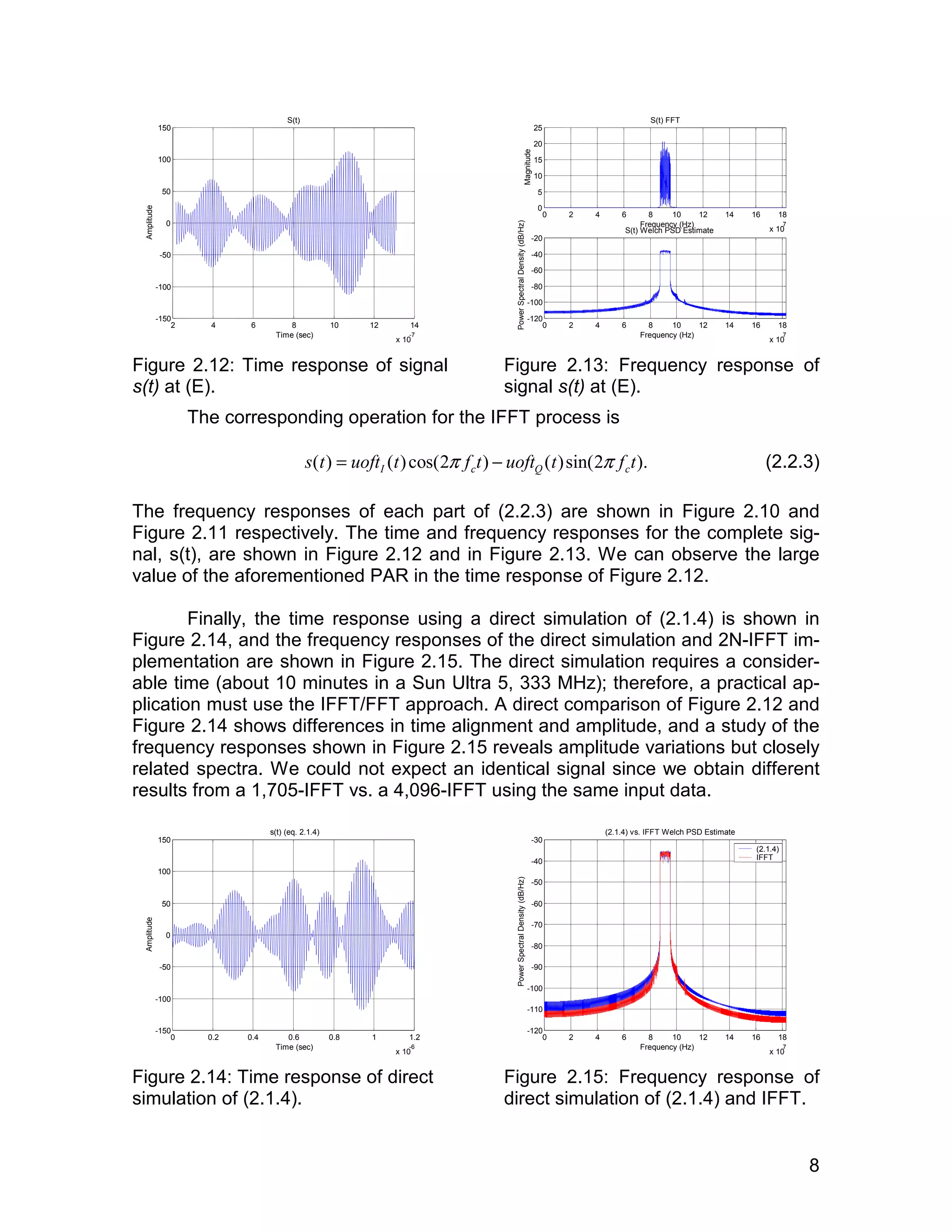
![9
3 OFDM Reception
As we mentioned before, the design of an OFDM receiver is open; i.e., there
are only transmission standards. With an open receiver design, most of the re-search
and innovations are done in the receiver. For example, the frequency sensi-tivity
drawback is mainly a transmission channel prediction issue, something that is
done at the receiver; therefore, we shall only present a basic receiver structure in
this report. A basic receiver that just follows the inverse of the transmission proc-ess
is shown in Figure 3.1.
4,096
FFT
G H
Figure 3.1: OFDM reception simulation.
F
I
J
OFDM is very sensitive to timing and frequency offsets [2]. Even in this ideal
simulation environment, we have to consider the delay produced by the filtering
operation. For our simulation, the delay produced by the reconstruction and de-modulation
filters is about td=64/Rs. This delay is enough to impede the reception,
and it is the cause of the slight differences we can see between the transmitted
and received signals (Figure 2.3 vs. Figure 3.7 for example). With the delay taken
care of, the rest of the reception process is straightforward. As in the transmission
case, we specified the names of the simulation variables and the output processes
in the reception description of Figure 3.1. The results of this simulation are shown
in Figures 3.2 to 3.9.
60
40
20
0
-20
-40
0 0.2 0.4 0.6 0.8 1 1.2
x 10-6
-60
r-tilde Inphase
Amplitude
150
100
50
0
-50
0 0.2 0.4 0.6 0.8 1 1.2
x 10-6
-100
r-tilde Quadrature
Time (sec)
Amplitude
Figure 3.2: Time response of signal
r_tilde at (F).
0 0.5 1 1.5 2 2.5 3 3.5
x 108
25
20
15
10
5
0
r-tilde FFT
Amplitude
-20
-40
-60
-80
-100
0 0.5 1 1.5 2 2.5 3 3.5
x 108
-120
Frequency (Hz)
Power Spectral Density (dB/Hz)
r-tilde Welch PSD Estimate
Figure 3.3: Frequency response of
signal r_tilde at (F).
fp=2fc LPF
r(t)
fc
r_tilde
r_info Fs=2/T to=td
r_data info_h
4-QAM
Slicer
a_hat](https://image.slidesharecdn.com/ofdm-sim-matlab-code-tutorialweb-141001030102-phpapp02/75/Ofdm-sim-matlab-code-tutorial-web-for-EE-students-13-2048.jpg)
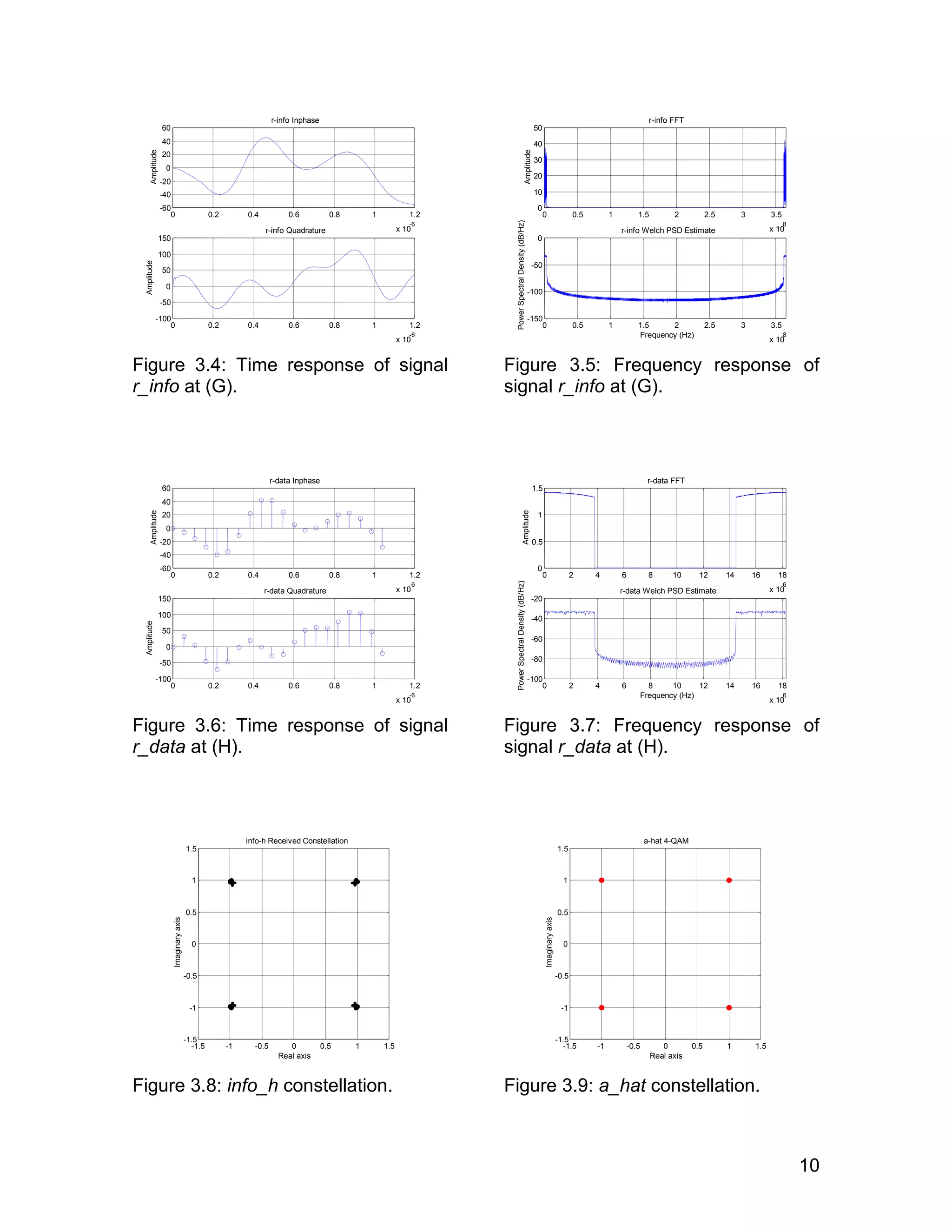
![11
4 Conclusion
We can find many advantages in OFDM, but there are still many complex prob-lems
to solve, and the people of the research team at the SARL are working in
some of these problems. It is the purpose of this project to provide a basic simula-tion
tool for them to use as a starting point in their projects. We hope that by using
the specifications of a working system, the DBV-T, as an example, we are able to
provide a much better explanation of the fundamentals of OFDM.
5 Appendix
5.1 OFDM Transmission
%DVB-T 2K Transmission
%The available bandwidth is 8 MHz
%2K is intended for mobile services
clear all;
close all;
%DVB-T Parameters
Tu=224e-6; %useful OFDM symbol period
T=Tu/2048; %baseband elementary period
G=0; %choice of 1/4, 1/8, 1/16, and 1/32
delta=G*Tu; %guard band duration
Ts=delta+Tu; %total OFDM symbol period
Kmax=1705; %number of subcarriers
Kmin=0;
FS=4096; %IFFT/FFT length
q=10; %carrier period to elementary period ratio
fc=q*1/T; %carrier frequency
Rs=4*fc; %simulation period
t=0:1/Rs:Tu;
%Data generator (A)
M=Kmax+1;
rand('state',0);
a=-1+2*round(rand(M,1)).'+i*(-1+2*round(rand(M,1))).';
A=length(a);
info=zeros(FS,1);
info(1:(A/2)) = [ a(1:(A/2)).']; %Zero padding
info((FS-((A/2)-1)):FS) = [ a(((A/2)+1):A).'];
%Subcarriers generation (B)
carriers=FS.*ifft(info,FS);
tt=0:T/2:Tu;
figure(1);
subplot(211);
stem(tt(1:20),real(carriers(1:20)));](https://image.slidesharecdn.com/ofdm-sim-matlab-code-tutorialweb-141001030102-phpapp02/75/Ofdm-sim-matlab-code-tutorial-web-for-EE-students-15-2048.jpg)
![12
subplot(212);
stem(tt(1:20),imag(carriers(1:20)));
figure(2);
f=(2/T)*(1:(FS))/(FS);
subplot(211);
plot(f,abs(fft(carriers,FS))/FS);
subplot(212);
pwelch(carriers,[],[],[],2/T);
% D/A simulation
L = length(carriers);
chips = [ carriers.';zeros((2*q)-1,L)];
p=1/Rs:1/Rs:T/2;
g=ones(length(p),1); %pulse shape
figure(3);
stem(p,g);
dummy=conv(g,chips(:));
u=[dummy(1:length(t))]; % (C)
figure(4);
subplot(211);
plot(t(1:400),real(u(1:400)));
subplot(212);
plot(t(1:400),imag(u(1:400)));
figure(5);
ff=(Rs)*(1:(q*FS))/(q*FS);
subplot(211);
plot(ff,abs(fft(u,q*FS))/FS);
subplot(212);
pwelch(u,[],[],[],Rs);
[b,a] = butter(13,1/20); %reconstruction filter
[H,F] = FREQZ(b,a,FS,Rs);
figure(6);
plot(F,20*log10(abs(H)));
uoft = filter(b,a,u); %baseband signal (D)
figure(7);
subplot(211);
plot(t(80:480),real(uoft(80:480)));
subplot(212);
plot(t(80:480),imag(uoft(80:480)));
figure(8);
subplot(211);
plot(ff,abs(fft(uoft,q*FS))/FS);
subplot(212);
pwelch(uoft,[],[],[],Rs);
%Upconverter
s_tilde=(uoft.').*exp(1i*2*pi*fc*t);
s=real(s_tilde); %passband signal (E)
figure(9);
plot(t(80:480),s(80:480));
figure(10);
subplot(211);](https://image.slidesharecdn.com/ofdm-sim-matlab-code-tutorialweb-141001030102-phpapp02/75/Ofdm-sim-matlab-code-tutorial-web-for-EE-students-16-2048.jpg)
![13
%plot(ff,abs(fft(((real(uoft).').*cos(2*pi*fc*t)),q*FS))/FS);
%plot(ff,abs(fft(((imag(uoft).').*sin(2*pi*fc*t)),q*FS))/FS);
plot(ff,abs(fft(s,q*FS))/FS);
subplot(212);
%pwelch(((real(uoft).').*cos(2*pi*fc*t)),[],[],[],Rs);
%pwelch(((imag(uoft).').*sin(2*pi*fc*t)),[],[],[],Rs);
pwelch(s,[],[],[],Rs);
5.2 OFDM Reception
%DVB-T 2K Reception
clear all;
close all;
Tu=224e-6; %useful OFDM symbol period
T=Tu/2048; %baseband elementary period
G=0; %choice of 1/4, 1/8, 1/16, and 1/32
delta=G*Tu; %guard band duration
Ts=delta+Tu; %total OFDM symbol period
Kmax=1705; %number of subcarriers
Kmin=0;
FS=4096; %IFFT/FFT length
q=10; %carrier period to elementary period ratio
fc=q*1/T; %carrier frequency
Rs=4*fc; %simulation period
t=0:1/Rs:Tu;
tt=0:T/2:Tu;
%Data generator
sM = 2;
[x,y] = meshgrid((-sM+1):2:(sM-1),(-sM+1):2:(sM-1));
alphabet = x(:) + 1i*y(:);
N=Kmax+1;
rand('state',0);
a=-1+2*round(rand(N,1)).'+i*(-1+2*round(rand(N,1))).';
A=length(a);
info=zeros(FS,1);
info(1:(A/2)) = [ a(1:(A/2)).'];
info((FS-((A/2)-1)):FS) = [ a(((A/2)+1):A).'];
carriers=FS.*ifft(info,FS);
%Upconverter
L = length(carriers);
chips = [ carriers.';zeros((2*q)-1,L)];
p=1/Rs:1/Rs:T/2;
g=ones(length(p),1);
dummy=conv(g,chips(:));
u=[dummy; zeros(46,1)];
[b,aa] = butter(13,1/20);
uoft = filter(b,aa,u);
delay=64; %Reconstruction filter delay
s_tilde=(uoft(delay+(1:length(t))).').*exp(1i*2*pi*fc*t);](https://image.slidesharecdn.com/ofdm-sim-matlab-code-tutorialweb-141001030102-phpapp02/75/Ofdm-sim-matlab-code-tutorial-web-for-EE-students-17-2048.jpg)
![14
s=real(s_tilde);
%OFDM RECEPTION
%Downconversion
r_tilde=exp(-1i*2*pi*fc*t).*s; %(F)
figure(1);
subplot(211);
plot(t,real(r_tilde));
axis([0e-7 12e-7 -60 60]);
grid on;
figure(1);
subplot(212);
plot(t,imag(r_tilde));
axis([0e-7 12e-7 -100 150]);
grid on;
figure(2);
ff=(Rs)*(1:(q*FS))/(q*FS);
subplot(211);
plot(ff,abs(fft(r_tilde,q*FS))/FS);
grid on;
figure(2);
subplot(212);
pwelch(r_tilde,[],[],[],Rs);
%Carrier suppression
[B,AA] = butter(3,1/2);
r_info=2*filter(B,AA,r_tilde); %Baseband signal continuous-time (G)
figure(3);
subplot(211);
plot(t,real(r_info));
axis([0 12e-7 -60 60]);
grid on;
figure(3);
subplot(212);
plot(t,imag(r_info));
axis([0 12e-7 -100 150]);
grid on;
figure(4);
f=(2/T)*(1:(FS))/(FS);
subplot(211);
plot(ff,abs(fft(r_info,q*FS))/FS);
grid on;
subplot(212);
pwelch(r_info,[],[],[],Rs);
%Sampling
r_data=real(r_info(1:(2*q):length(t)))... %Baseband signal, discrete-time
+1i*imag(r_info(1:(2*q):length(t))); % (H)
figure(5);
subplot(211);
stem(tt(1:20),(real(r_data(1:20))));
axis([0 12e-7 -60 60]);
grid on;](https://image.slidesharecdn.com/ofdm-sim-matlab-code-tutorialweb-141001030102-phpapp02/75/Ofdm-sim-matlab-code-tutorial-web-for-EE-students-18-2048.jpg)
![15
figure(5);
subplot(212);
stem(tt(1:20),(imag(r_data(1:20))));
axis([0 12e-7 -100 150]);
grid on;
figure(6);
f=(2/T)*(1:(FS))/(FS);
subplot(211);
plot(f,abs(fft(r_data,FS))/FS);
grid on;
subplot(212);
pwelch(r_data,[],[],[],2/T);
%FFT
info_2N=(1/FS).*fft(r_data,FS); % (I)
info_h=[info_2N(1:A/2) info_2N((FS-((A/2)-1)):FS)];
%Slicing
for k=1:N,
a_hat(k)=alphabet((info_h(k)-alphabet)==min(info_h(k)-alphabet)); %
(J)
end;
figure(7)
plot(info_h((1:A)),'.k');
title('info-h Received Constellation')
axis square;
axis equal;
figure(8)
plot(a_hat((1:A)),'or');
title('a_hat 4-QAM')
axis square;
axis equal;
grid on;
axis([-1.5 1.5 -1.5 1.5]);](https://image.slidesharecdn.com/ofdm-sim-matlab-code-tutorialweb-141001030102-phpapp02/75/Ofdm-sim-matlab-code-tutorial-web-for-EE-students-19-2048.jpg)
![16
5.3 Eq. (2.1.4) vs. IFFT
%DVB-T 2K signal generation Eq. (2.1.4) vs. 2N-IFFT
clear all;
close all;
Tu=224e-6; %useful OFDM symbol period
T=Tu/2048; %baseband elementary period
G=0; %choice of 1/4, 1/8, 1/16, and 1/32
delta=G*Tu; %guard band duration
Ts=delta+Tu; %total OFDM symbol period
Kmax=1705; %number of subcarriers
Kmin=0;
FS=4096; %IFFT/FFT length
q=10; %carrier period to elementary period ratio
fc=q*1/T; %carrier frequency
Rs=4*fc; %simulation period
a=-1+2*round(rand(M,1)).'+i*(-1+2*round(rand(M,1))).';
A=length(a);
info = [ a.'];
tt=0:1/Rs:Ts;
TT=length(tt);
k=Kmin:Kmax;
for t=0:(TT-1); % Eq. (2.1.4)
phi=a(k+1).*exp((1j*2*(((t*(1/Rs))-delta))*pi/Tu).*((k-(Kmax-
Kmin)/2)));
s(t+1)=real(exp(1j*2*pi*fc*(t*(1/Rs))).*sum(phi));
end
infof=zeros(FS,1);
infof(1:(A/2)) = [ a(1:(A/2)).'];
infof((FS-((A/2)-1)):FS) = [ a(((A/2)+1):A).'];
carriers=FS.*ifft(infof,FS); % IFFT
%Upconverter
L = length(carriers);
chips = [ carriers.';zeros((2*q)-1,L)];
p=1/Rs:1/Rs:T/2;
g=ones(length(p),1);
dummy=conv(g,chips(:));
u=[dummy(1:TT)];
[b,a] = butter(13,1/20);
uoft = filter(b,a,u);
s_tilde=(uoft.').*exp(1i*2*pi*fc*tt);
sf=real(s_tilde);
figure(1);
plot(tt,s,'b',tt,sf,'g');
figure(2);
pwelch(s,[],[],[],Rs);
hold on;
pwelch(sf,[],[],[],Rs);
hold off;](https://image.slidesharecdn.com/ofdm-sim-matlab-code-tutorialweb-141001030102-phpapp02/75/Ofdm-sim-matlab-code-tutorial-web-for-EE-students-20-2048.jpg)
![6 References
[1] ETS 300 744, "Digital broadcasting systems for television, sound and data
services; framing structure, channel coding, and modulation for digital terres-trial
television,” European Telecommunication Standard, Doc. 300 744,
17
1997.
[2] R. V. Nee and R. Prasad, OFDM Wireless Multimedia Communications,
Norwood, MA: Artech House, 2000.
[3] J. A. C. Bingham, "Multi-carrier modulation for data transmission: An idea
whose time has come", IEEE Communications Magazine, vol.28, no. 5, pp.
5-14, May 1990.
[4] A. V. Oppenheim and R. W. Schafer, Discrete-Time Signal Processing,
Englewood Cliffs, NJ: Prentice Hall, 1989](https://image.slidesharecdn.com/ofdm-sim-matlab-code-tutorialweb-141001030102-phpapp02/75/Ofdm-sim-matlab-code-tutorial-web-for-EE-students-21-2048.jpg)